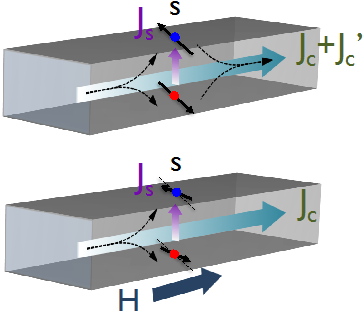A new magnetoresistance effect occurring in materials with strong spin-orbit coupling

Researchers of the Nanodevices group, in collaboration with groups from the CFM and DIPC, both institutions also located in Donostia-San Sebastián, have discovered a new magnetoresistance effect occurring in materials with strong spin-orbit coupling. This new effect has been recently reported in the prestigious journal Physical Review Letters and featured as an Editor's Suggestion.
These materials, which include metals such as platinum or tantalum, are capable of generating a spin current from an electrical current (and vice versa) by means of the so-called Spin Hall effect. For this reason, these materials are of utmost importance in the field of spintronics—the generation, transmission and detection of spin currents in materials and devices. The ultimate goal of spintronics is a deeper understanding of the charge-to-spin conversion and transport phenomena at the nanoscale in order to design new functional and efficient devices that are not only based on the injection, transport and storage of electrical charge, but also its spin, which could revolutionize conventional electronics and expand its limits. The researchers show that by means of this novel magnetoresistive effect, it is now possible to study the spin transport properties of these materials without the need to fabricate complex devices and/or involve interfaces between different materials.
When an electric current is applied to a thin film of a material with strong spin-orbit coupling (typically of a few nanometers thick), a spin current is generated in the transverse direction—that is, along the thickness of the film—via the direct Spin Hall effect, which in turn produces an electric current (via the inverse Spin Hall effect) that adds to the initial applied current. This effect—small since it is due to a second-order correction—causes a reduction in the resistivity of the film, and is maximal when the film thickness is on the order of the spin diffusion length, which is the average distance that a spin can travel through the material without suffering a collision that may cause a change in its state. If an applied magnetic field is not collinear to the direction to which the spin points, they can be forced to precess via the so-called Hanle effect, thereby generating a modulation in the resistivity of the material. According to Saul Velez, first author of the work, "This new phenomenon could open the possibility to study the spin transport in materials and systems not yet explored."
Fèlix Casanova, last author and supervisor of the work, says, "This new effect also allows to study the spin transport properties of known materials, and to compare the results with the ones obtained with other techniques or devices."
More information: Saül Vélez et al. Hanle Magnetoresistance in Thin Metal Films with Strong Spin-Orbit Coupling, Physical Review Letters (2016). DOI: 10.1103/PhysRevLett.116.016603
Journal information: Physical Review Letters
Provided by Elhuyar Fundazioa


















